














As the days shorten and temperatures drop into frozen eyelashes and frosty beards territory, we know our latest issue of Saskatoon HOME will brighten your day. During this snowy season, our homes are especially important for us prairie folk. For many of us, just the thought of stepping outside chills our bones. But bundle up and go we must, taking comfort in knowing we’ll return to our hibernation heaven. We like to think your winter issue of Saskatoon HOME adds to what you love about spending time in cozy comfort.

In this issue, meet a patient and persistent family who went on a multi-year odyssey waiting for their perfect home. And you’ll appreciate the massive labour of love that has brought new life to a Victorian-style country home. On the nostalgic side, our resident historian Jeff O’Brien takes you on a roadtrip back to the days when picking up and moving houses was commonplace. From farmhouses hauled to downtown Saskatoon to today’s more complicated home moving industry, you’ll learn all about what it really means to be upwardly mobile. For all you gardeners who look out wistfully at the mounting snow, we’ve got some ideas on how to create an interesting wonderland that looks beautiful in a white landscape. And lest we forget about what really makes a house a home, Maureen’s Kitchen shows us of how we can make a mealtime occasion of being together. Stoke the fires with a romantic dinner for two.
With Saskatoon HOME in hand, it’s time for a well-deserved winter break. So grab a steaming mug of your favourite winter beverage, reach for that afghan or warmest pet, settle in your comfiest chair—and enjoy!
Issue 60, Winter 2022 ISSN 1916-2324 info@saskatoon-home.ca
Amanda Soulodre
Rob Soulodre
Editor
Karin Melberg Schwier
Contributors
Jeff O’Brien
Julie Barnes

Karin Melberg Schwier
Lillian Lane Maureen Haddock
The booking deadline for advertising in the Spring 2023 issue is January 20, 2023
Contact Amanda for more information. Email: amanda@saskatoon-home.ca Phone: 306-373-1833 Text: 306-717-0663
Saskatoon HOME is printed four times a year. Subscribe to receive every issue direct to your mailbox for $20/year. Visit www.gethomemagazine.ca
Connect with us: www.saskatoon-home.ca www.facebook.com/saskatoon.home /saskatoon.home
Saskatoon HOME is published by: Farmhouse Communications
Telephone: 306-373-1833 Fax: 306-500-2993 info@saskatoon-home.ca www.saskatoon-home.ca
No part of this publication may be copied or reprinted without the written consent of the publisher.
Publications Mail Agreement # 41856031


Most first-time homebuyers wouldn’t bid on a 3,400 square-foot Victorian-style home in need of major restoration and repair, unless they had a background in one of the building trades or a hefty budget to hire the people who do.

But Jason Hattie isn’t most people. Armed with loads of
ambition and a willingness to learn everything from wallpapering to drywalling, he’s been busy restoring his historical home for six years and counting.
He’s quick to explain that it’s been a team effort, with both friends and family pitching in
to lend a hand. “One of my longtime childhood friends, Scott Elash, also happens to be a really great carpenter. He was between places after selling his home, and offered his services in helping with the restorations in exchange for room and board,” says Jason. “The house wouldn’t look nearly as nice as it does without his help.”
Built in 1906 in Hanley, Saskatchewan, the stately home now sits on Jason’s acreage, 10 minutes east of Saskatoon. (It was moved from Hanley by previous owners in 1975). Jason, a musician, was 29 when he purchased the home in 2016. At the time, he says, “I was trying to figure out if I was
going to stay in Saskatoon for a while or if I was going to try to move somewhere to keep pursuing music."
With financial support from his parents, he made an offer on the home. It was accepted, and he was later told that although he wasn’t the highest bidder “we were the only people who had



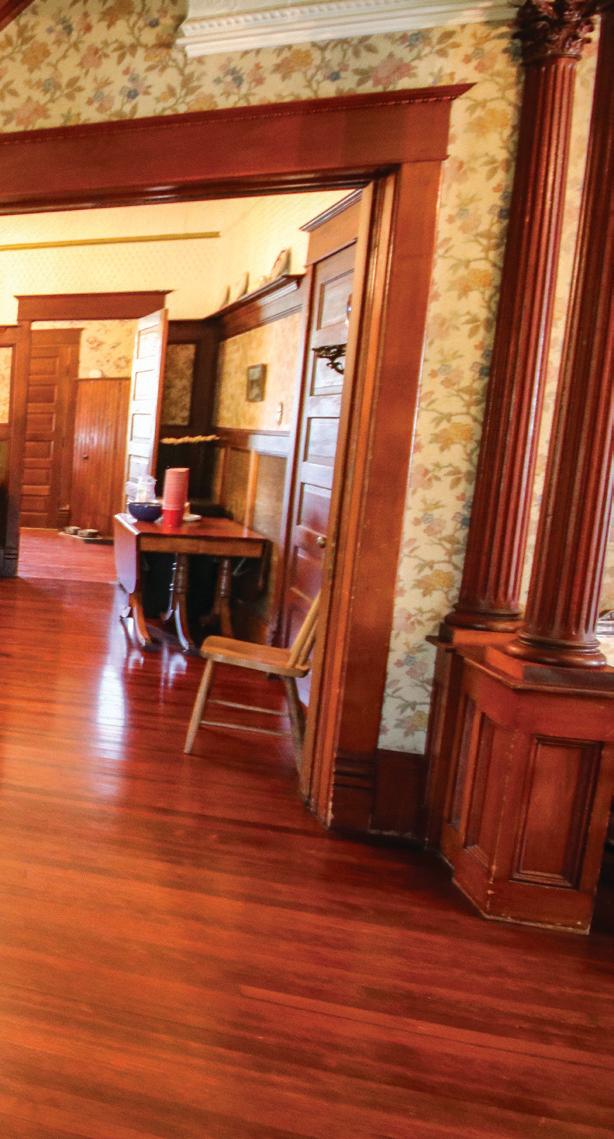

plans to live in it and fix it back up.” That earned him favour with the sellers.
The first major undertaking was to replace the front deck, as the stairs were rotten and there were soft spots in the deck. Together with his uncle, Doug Quennell, he restructured the deck
and raised the roof above it, which supports a large balcony.

“The floor on the balcony was spongy from using incorrect materials, so we restructured that as well,” says Jason.
Next, came the interior floor restoration—an early priority so that Jason could bring in his furniture, and start sourcing new pieces. Shag carpeting on both floors—including in the ensuite bathroom—was ripped out. The hardwood below happened to be in good shape, and Jason arranged to have it refinished professionally.

That step “was our kickstart to the whole project, because once we had the floors redone, you could see such a major transformation already,” says Jason. “We thought, ‘OK, this will work.’”


A few furniture pieces came with the house, and Jason credits his mother with finding some antique gems at auctions.
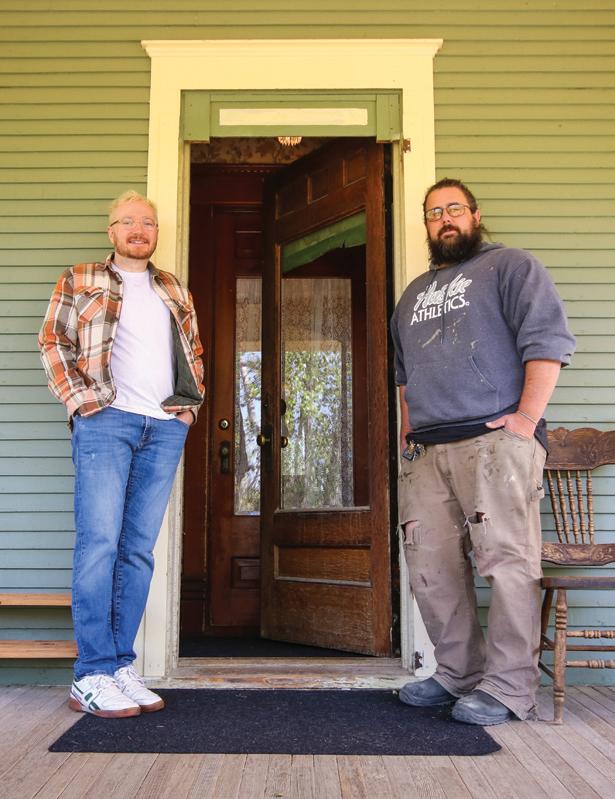
“My mom really did a lot of the work with the decorating,” he says. “For the first time in our lives, we found ourselves with the same interests and goals and we had something to talk about and really bonded over it. It had a pretty noticeable impact on my family relations.”
Jason leans towards wood furniture in keeping with the home’s early 1900s aesthetic. He’s also found the odd piece on Kijiji. “Especially in our region, there are tons of great deals on Kijiji because it’s a space that doesn’t get as much traffic as Facebook Marketplace.”

Aside from the kitchen and interior hallway, all the wallpaper on the main floor is original, says Jason. “You can tell because there are spots where you can see through to the backing board and there are no other layers of wallpaper underneath. I think a lot of people might have looked at that and thought to paint it, but I like it and think it’s what adds charm to the house and gives it its museum qualities.”

Although he sourced new wallpaper for parts of the upstairs, he was careful to choose patterns in keeping with the home’s history.

“We renovated one of the bathrooms first thing

because they were not in the greatest shape,” says Jason. They hired out much of the plumbing and electrical work, but took on as much DIY as possible.
By early 2020, Jason was living in the house with Scott and one other friend. They were also hosting three guests when the pandemic broke out, “so they were all stuck here for a month,” says Jason. With six people living under one roof, they needed to fast-track two more bathroom renovations, which they handled by converting a sixth bedroom into two separate bathrooms.
Maintaining the elegant Victorian aesthetic was a priority for Jason in each of these projects, as witnessed in the features and finishes he sourced—from the cast iron clawfoot tubs, to the damask wallpapers, to the wainscotting and crystal chandeliers.

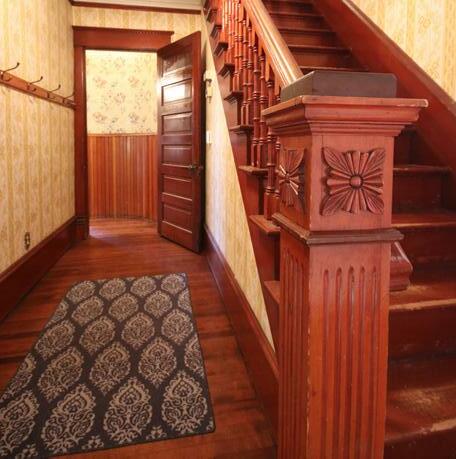
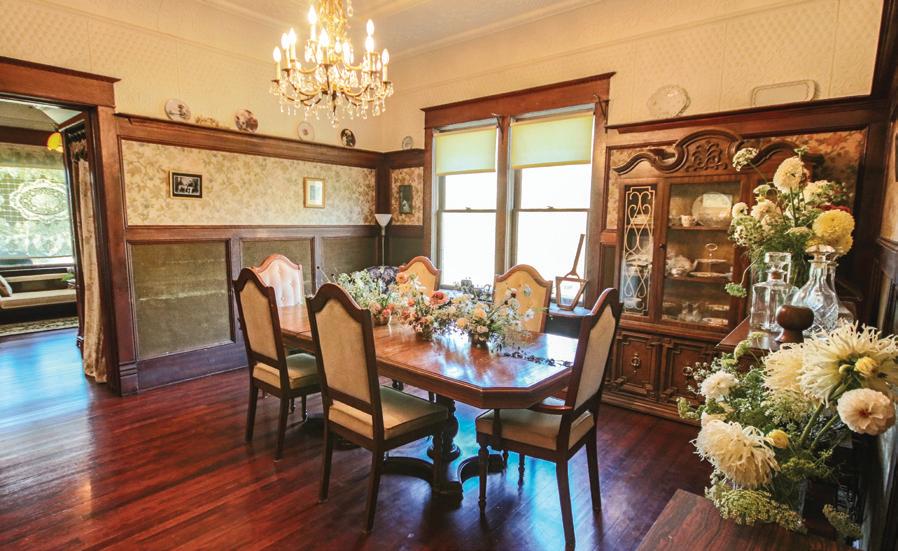

Pre-pandemic, Jason had been “picking away at the renovations” squeezing in a few hours of work where he could. “When the pandemic happened, between Scott and myself, we decided to go full steam and get it finished because now is the time. At that point, it became eight to 12-hour days.”
“The
All of the wood trim throughout the house is original. “It was really well kept,” says Jason, who loves to decorate with blooms from Honest Floral. fireplace, as far as I can tell, wasn’t touched from the original install,” says Jason.







The kitchen is still a work-in-progress. Jason plans to add a window, open shelving, and a fixture from which to hang pots and pans.
One project he kicked into high gear was the refinishing of the exterior. Every summer for the first four years, he had set up scaffolding on one side of the house, “and I would go out there with a barbecue scraper and peel off all the old paint,” he says. “Because it was so old, I wanted to get more of a hands-on feel to it and ensure there wasn’t going to be a lot of issues with siding needing repair.”
Once the old paint was scraped away, and the pandemic cleared Jason’s calendar, a group of friends helped him prime the siding—by hand—over the course of a weekend. After that, Jason rented a sprayer and added a few coats of the sage green paint that graces the exterior today.
The kitchen renovation was one of the last major projects to tackle. Jason and Scott “dug through some old photos, and paintings—oddly enough—of Victorian and Edwardian-era kitchens” for design inspiration. What stood out to them was the absence of built-in cupboards. “It was all furniture back then. They would have hauled all of their kitchen from one house to the next.”
And so they scrapped plans for cabinets and sourced antique furniture instead. Today, the kitchen is “three-


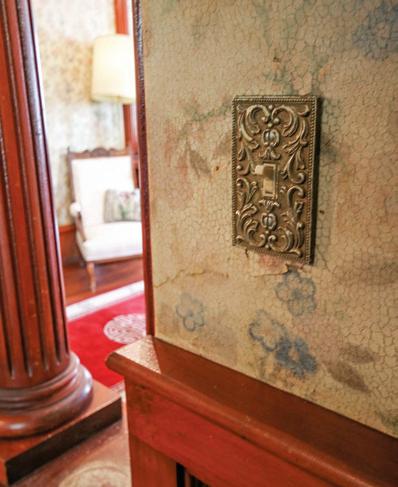
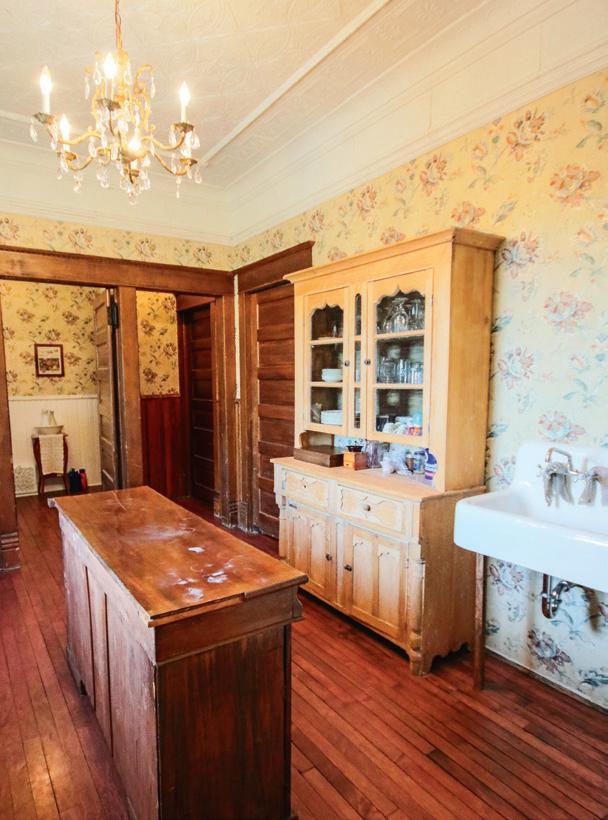
quarters done,” says Scott. He plans to install some open shelving and add a fixture for hanging pots and pans.
Despite being unfinished, the kitchen is still fit to host family gatherings. He happily entertained his family for Thanksgiving dinner last fall, adding that hosting friends and family is the best part about owning the home. He has even begun to rent his home for weddings and private functions, allowing others to experience the grandeur of his graceful home.
Six years ago, Jason assumed he’d have to hire out most of the labour required to make his new-to-him home liveable and true to its Victorian vernacular.
“But as time went on, and the more that got done, the less I felt like I needed to rely on other people— especially once Scott got into the mix. Now, we look at it like there’s nothing we can’t fix or figure out,” Jason insists. “I feel confident I can tackle projects that years ago I wouldn’t have had any business taking on.”

Dogged persistence and patience paid off for a young Saskatoon family. For Greg and Kristin Hetterly, there was never a question about returning to the city after college in 2007; they knew they wanted to start a family in their hometown. It didn’t take long for them to settle on
not only the neighbourhood generally, but also some specific houses on Empire Avenue in Richmond Heights. Problem: none were for sale. It would be a ten year wait before that changed.
since 2001 in high school,” says Kristin, an architectural technologist. The couple owns First Filter Service, a local third-generation family business. “We grew up in Silverwood and really like the north end.” Kristin spent over a decade with Saskatoon Public Schools,

managing contracted construction work. Before buying into the family business, Greg installed water meters for the City. During the five years he did that, he went into thousands of homes.
Several on Empire left an impression.
“We have been togetherBY: KARIN MELBERG SCHWIER PHOTOS: LILLIAN LANE
“Greg always remembered those,” says Kristin. “I still have our notes with addresses, square footages we found on the City’s website, assessment values. We’d look that over, prioritize our favourites and try to figure out if we could afford anything. If they ever did come up for sale.”



Following their first home purchase in Saskatoon and the addition of Phil the cat in 2007, the couple’s first



daughter Blair was born in January 2015. Second daughter Jordan came along in October 2016. The 720-square foot bungalow they were living in on Edward Avenue in North Park was starting to feel small.
“I walked the streets in North Park and Richmond Heights many times with my girls, just looking. When the front streets got old, we walked back alleys, too,” says Kristin.
A favourite room has got to be the main floor living room, Kristin says. “We could call it our yoga studio, dance floor, movie theatre, our performing arts space.”

Armed with their wish list, the couple was intent on finding a home with a few particular features. They wanted a bungalow for easy aging in place, a walkout or at least that potential, good views with proximity to the river, ideally backing onto the park, a good school and a diverse neighbourhood. A mature home with good bones was the ideal. They knew if the house was sound, they could renovate to meet their needs.
Following the ‘it can’t hurt to ask’ rule, Greg and Kristin drafted a letter to introduce themselves to owners of seven particularly coveted properties. The letter
assured the homeowners there was no rush. Greg and Kristin were prepared to wait for the right property, and didn’t want to miss out on a home they admired.

“We dropped off the letters in mailboxes the first week of December 2017,” recalls Kristin.
The phone rang one Sunday evening a couple of weeks later.
“It was from a couple whose house we really liked, at least from what we could see outside. The owners were Pat and Frank. When she told me the address, I knew exactly which one it was.”
The house was a 1966built Boychuk built home that had an addition and
renovation done in the late ‘70s by the second owners. Pat and Frank Lang bought it privately in 1979, right after the renovations were complete. The couple had, coincidentally, turned down a suite in a seniors’ home the day before receiving the Hetterlys’ letter. They had been on the fence about a care home, and Pat felt conflicted they turned down a spot when selling their house could have been included in the decision-making process.
“I assured her that she made the right decision if they were uncertain,” says Kristin. “Pat and Frank lived, loved and cared for this house for 40 years. It was very solid with amazing features and
potential. I told her if the house was right for us, we would wait and buy it when they were ready.”
Pat and Frank agreed to let Greg and Kristin see the house and once holidays and vacation schedules opened up, the visit happened in March.
“When Greg and I arrived, they greeted us and gave us a very honest and open tour of the house,” says Kristin. “They’d been there since 1979, and knew all of its features, quirks and tired areas. It took Greg and I about two minutes before we looked at each other. We couldn’t stop smiling. We knew it was a good fit.” They agreed to stay in
touch. In fact, Pat and Frank welcomed them back with the girls later that spring.
“We continued to stop by now and then over the next year and a half. We had nothing more than a handshake and a letter of intent that we had drafted. But even with just that, we started working on reno ideas.”
Kristin drafted plans based on the visits, Google Earth measurements and the known square footage. She produced a variety of possibilities for the interior layout, including 3D models. At one point, the master bedroom and the kitchen swapped locations. Two big challenges involved moving the main staircase in the house; it went from U-shaped (east to west) to T-shaped (north south).
The services coming into the house also had to be relocated.
“There were a few items that we knew would make the house more livable and enjoyable for our family,” she says. “Connect the kitchen to the dining and living room, create direct entry into the attached garage through the basement. We wanted a master bedroom with an ensuite. Greg and I played with many possibilities and finally settled on the layout we liked best.”


Because the reno was so extensive, it would be an all-at-once job. While they waited for Pat and Frank to make their decision, Greg and Kristin had time to plan room by room, selecting all finishes, hardware, plumbing fixtures, cabinets and other items “right down to SKU numbers and prices.”
It allowed them, says






Kristin, to have detailed plans, specs and budget. If they could pull the ripcord. Was it a gamble? “It was fun and we enjoyed the exercise, but there was no guarantee the house would be ours,” Kristin says. “But the entire interaction with Pat and Frank felt honest and genuine. We trusted them.”

In September 2019, there was another phone call, the one the Hetterlys had been hoping for. Pat and Frank were ready to sell and move. There was zero negotiation and all parties were happy.
“We took possession of the house on Friday, November 15th,” Kristin says. “We had a big house tour with friends and


family on Saturday, and on Monday the contractors were on site to start the demo.” The couple selected Sole Construction as the general contractors and settled on a fixed price contract with a four month schedule. Kristin kept parts of the work for sub-trades she worked with on past projects, and she and Greg wanted to do the kitchen themselves. Used to managing construction projects, Kristin was on site nearly every day for four months.
Then the pandemic hit in 2020. Daycares shut down the week of March 16. The water to the house was turned on March 19 and the family moved in March 23. The renovation
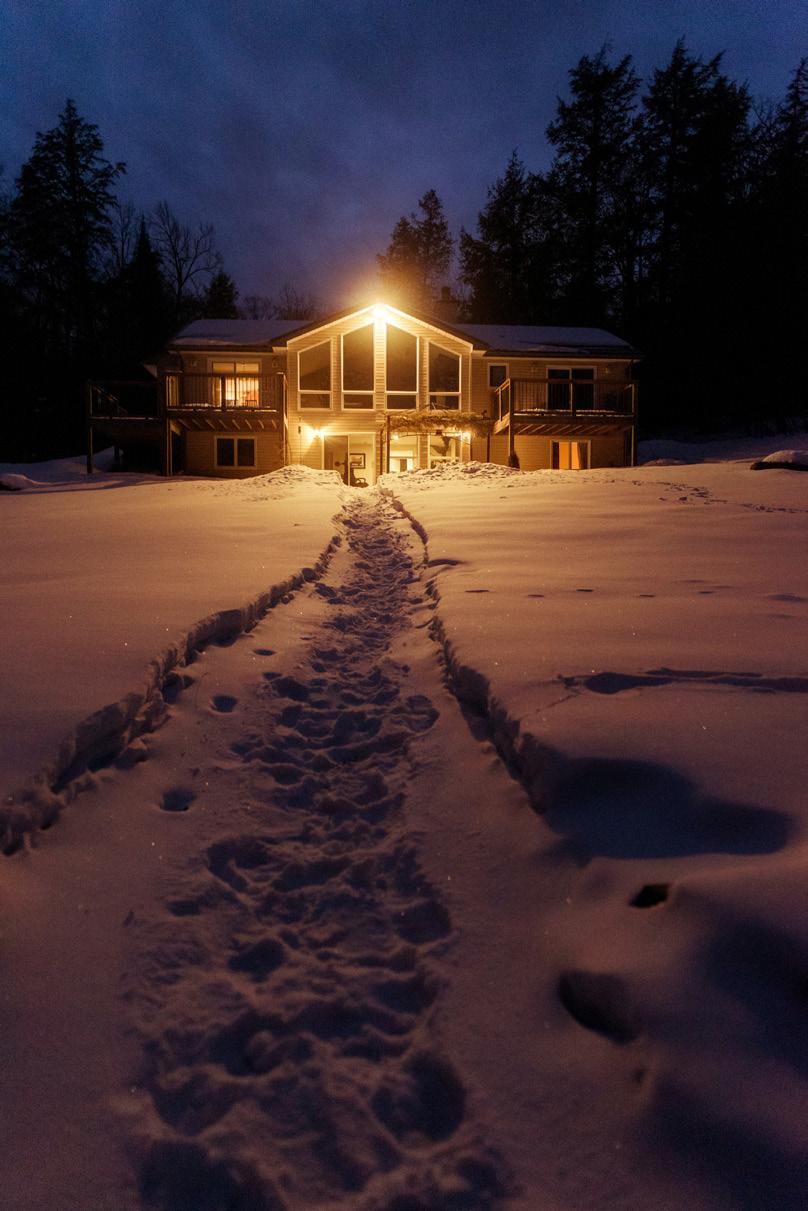

Whether it’s a car crash, damage to your home, or a stolen possession, things get expensive quickly if you don't have the right insurance. With over 300 years of combined experience, the staff at Rayner Agencies offer the professional advice and insurance products you need to protect yourself, your family, and your property.
Contact one of our brokers for a no obligation assessment of your insurance needs and current coverage.
We'll

As an architectural technologist, Kristin didn’t shy away from the challenging elements of the renovation. One of the biggest was closing off the main staircase and constructing new in another location.


was completed just in time before lockdowns made isolation a necessity. The family found themselves with plenty of at-home time to enjoy the opportunity Pat and Frank had given them.

“Our favourite part is the space, the connection throughout and to the outside. Moving the main staircase made a big difference in feel. No one feels isolated, but we can still have individual space.”
When the family moved in, Saskatoon was shutting down. The view across the park to the river had fewer
lights. Traffic on Circle Drive and Spadina Crescent diminished. People even stopped going to the park. Now the family is witness to rejuvenation, not only the one inside their home but outside.
“Over the last two and a half years, we have watched as the lights come back on, traffic is moving and the park being used and enjoyed again,” says Kristin. “We are thankful every day that this is where we call home.”
Karin Melberg Schwier• complete removal, replacement of wall finishes, insulation, vapour barrier • complete replacement, upgrade of electrical system, mechanical, plumbing
all new windows, exterior and interior doors
all new cabinets, counters, fixtures • remove, fill in of original stairs, construction of new staircase • structural work to support layout changes, including 17 beams
new flooring throughout • new water, sewer lines
















Shedding oneself of accumulated possessions can be a monumental task for seniors—really for most people—especially after years of collecting and acquiring, after countless good intentions to “get rid of some of this stuff some day.” Being surrounded by cherished things, even just
stuff, can be a comfort, a reminder of a time without confusion and uncertainty. But a cluttered home can create barriers to a new phase of life.
Fran Edwards recently helped an older friend move from her home to a care facility.
“It was a huge job,” says
Fran. “She had been a very active, social lady. With no family living close, and declining health, the job of downsizing was more than she could handle.”
Nicholas Fraser is well acquainted with the practical moves and emotional pitfalls that come for seniors thinking about moving, and
 BY: KARIN MELBERG SCHWIER
BY: KARIN MELBERG SCHWIER
making the difficult move to shed some excess.
“There are so many meaningful things we cherish, but as we get older, our circumstances change,” says Nicholas. “We can get mired down by memories when we think about
what to do with our possessions. Sentimentality is okay, but the anxiety it might bring can also be paralyzing.”
Some guidance is a definite help, Fran agrees.
“You need someone to help you decide what you need and what you want to take. When you sort through things, you often find something that you forgot you had. That starts a whole flood of memories,” Fran says. “It’s distracting. Someone who helps you think about whether you really need that thing makes the task easier.”
For someone like Fran’s friend who faced a monumental task, “it’s way easier to do nothing. If you’re
feeling unwell and getting older, it’s hard to think about packing up and finding new homes for all your stuff,” Fran says. “It’s overwhelming trying to decide what to take to your new place or who will want the other things, so you’re stuck.”

After a long career in the non-profit sector, Nicholas had a lot of experience under his belt helping friends and family downsize, move and clear their estates to help seniors live with less clutter. Using this experience he opened his Saskatoon-based business called Transitions. He offers guidance to people who want to downsize; he appraises and documents possessions, manages estate sales, and cleans homes in preparation for sale.
With all of this experience Nicholas says there are several simple considerations that will make the shift easier and less formidable. These are his top eight.
1. Prioritize: What items are important to you? What is your lifestyle? Answering this will help you to determine where and how you want to live, and what you take with you. Understanding what your next-step home will look like may help you understand how to prioritize. Is the next destination a condo, assisted living, personal care home, private care home or some other option? Visualizing this space helps to set your priority list.
2. How much? What are possibilities for storage at your new home? Are there rules about bringing your own furnishings? How much space will you have? Focus on what you want to take with you; it’s okay to focus on yourself and the future. But learn what limitations there might be.
3. Inheritances: Keeping things in the family helps get past the sentimentality associated with possessions. It’s good to gift heirlooms and meaningful items to family,

and to give gifts to friends, but ask this question. Do they actually want it or do they feel pressured to accept? On the other hand, be wary of those who might take advantage of your generosity.

4. Online selling: It can be a great way to clear your home and make some money. If you are planning to use an estate dispersal service like Transitions, auctions or an estate purchaser, arrange for an assessment or consultation before selling anything. Try not to overpurge before getting a clear picture of what you have. Make sure services and people that you are inviting into your home are licensed businesses with insurance.
5. Donations: There are many great charities that accept household items. Many offer home pick-ups. Thinking about those who really need your donation can help when parting with possessions.
6. If you hire a service: Get a contract and understand how the service will leave the home once completed. Will they leave the home empty and cleaned to your specifications? Whether it’s left ready for sale or possession by new owners, or simply having keys
returned to the landlord, it should be on your timeline.

7. But I love my rose tufted Victorian sofa!: Styles and trends change; the collectibles and decor you adore might not be popular today. And something you never thought had much value might surprise you. Get a qualified appraisal and have your items inventoried. It will help you understand the current value of what you are selling, donating or giving away.
8. A new home sweet home: When you get there, make sure that you are comfortable and have the pieces you treasure. Furniture, decor, personal items and memorabilia can be comforting, but don’t let them overpower.










Anyone familiar with J.R.R. Tolkien’s Lord of the Rings remembers with heart-wrenching clarity how Gollum was tortured by the One Ring, his “precious.” It was eventually his demise. Maybe a little heavy handed as an analogy for seniors who cling to the contents of their households, but it is a cautionary tale.
“Helping my friend was a huge learning experience for
me,” Fran admits. “I’ve asked my family if there’s anything in my house they want. I find when things are gone, it is definitely freeing. When we used to visit my mother and admire something in her house, she would say, ‘Take it. I’m not using it.’ We had to be careful what we admired.”
Nicholas says the idea is not to get rid of everything, but to be intentional.
“These items are things you’ve gathered throughout your life,” says Nicholas. “Remember, things themselves aren’t memories. If you let something go, it doesn’t make the life, experience or person that it represents any less important. Stuff can be paralyzing, preventing you from freedom and comfort that should be the goal of downsizing.”
“My parents raised seven daughters on a farm with no electricity or running water,” Fran says. “They never had a lot of material things but we knew we were loved. Their legacy lives on in their children, grandchildren, great-grand children and the others that will come. That is what is important.”
Melberg SchwierWe normally expect buildings to stay where we put them. Usually they do. But sometimes, especially when Saskatoon was younger, buildings get picked up and plopped down somewhere else. Houses, apartment blocks, offices, warehouses, stables, barns—pretty much any type of building you can imagine. Someone once even moved an old Saskatoon streetcar out to Wakaw Lake to use as a cabin.
Mostly it was a matter
of economics. Back in the day, it was often cheaper to move a building than demolish it and build new. Developers even advertised buildings for auction and removal as a way to make money. So did tenders for city-owned properties. As well, by the 1920s, houses that failed to meet Saskatoon’s increasinglystringent building codes were being moved just outside city limits, into the then-Rural Municipality of Cory where standards were considerably lower.
Moving an old farm house into town was also a quick way to get a new home on a just-purchased lot. Saskatoon suffered a severe housing shortage after the Second World War. It was exacerbated by the post-war scarcity of building materials, and by the city’s rapid growth, both from returning soldiers and the increasing exodus of people from rural Saskatchewan. Some out-of-towners brought their houses with them. But farm buildings could be picked
 BY: JEFF O’BRIEN
BY: JEFF O’BRIEN
up for a song, and dozens of them each year found new homes in Saskatoon, enough that by 1961, an estimated seven to eight per cent of Saskatoon’s total housing inventory had been brought in from outside.
These houses frequently failed to meet Saskatoon’s aesthetic standards. “Far be it from me to deny anyone a home,” one angry resident wrote to the newspaper in 1948. “But scrap heaps dragged in to become hovels… are unsightly and unsanitary, and certainly
deprive us of that name we prize, ‘The Beautiful Saskatoon.’”
Under provincial legislation, however, the city had no power to prohibit buildings just because they were ugly. As long as they met the building code, whether they were painted or not, was entirely up to the owners. Even in the cities, the hardships of the 1930s and ‘40s meant basic maintenance had been neglected. For farm families struggling just to eat, putting on a fresh coat of paint was a low priority. Partly as a consequence of this, some of the city’s outlying districts in the 1940s and ‘50s looked a lot like shanty towns.
Once upon a time, most of what’s now the downtown
central business district was residential, full of small apartment buildings, single detached homes and plenty of empty lots—a legacy of previous cycles of boom and bust. That changed as money and people began






flowing into Saskatoon in the 1950s. To make room for new commercial buildings, many of those downtown houses and small apartments were moved to different neighbourhoods. (Some of them are still there. For



City of Saskatoon Archives - 1075-6-006
the story of one of those downtown houses, see the Spring 2023 issue of Saskatoon HOME coming out in March).
We’d done something like this before. In 1930, the city’s downtown Chinatown
district was completely cleared to make way for the new Saskatoon Technical Collegiate. This was the oldest part of downtown, by then a hodgepodge of aging residential and commercial buildings jammed together where River Landing is now. Some buildings in the area, like the Old Knox Church on Spadina Crescent, were sold at auction. But the Chinatown buildings on 19th Street were all picked up and moved into Riversdale.
Moving a building was a complex undertaking. There were city permits and paperwork to fill out. Companies doing the work had to be specially licensed and bonded in order to cover damage to the roads and trees. When the two large houses next to the YMCA on 20th Street were moved to North Park in 1954, Spadina Crescent residents screamed bloody murder at the “massacre” of trees along the route, which had been inexpertly trimmed by the moving crew to make way for the houses. Power
and telephone lines also had to be dealt with along the route, as did the power lines for the city’s streetcar and trolley buses. In cases where a route crossed a trolley line, moves were scheduled for after midnight after the buses had all gone to bed.
Developers who didn’t do their homework ran into problems. In the fall of
1961, the owner of a large house at 1010 McPherson Avenue decided to put up an apartment building in its place. “Excellent 8-room family dwelling to move off,” the advertisement read. “What offers?” None, as it turned out. Instead, he jacked it up and put it on a truck, then proceeded to park it on the street. Where it sat for the next two weeks, blocking almost the entire roadway while he wrangled with the city over the permits to move it. Finally, it ended up on blocks in an empty lot at the edge of town. “The homeless home,” the newspaper called it. Vandalized and rapidly deteriorating, it was finally demolished in 1963.

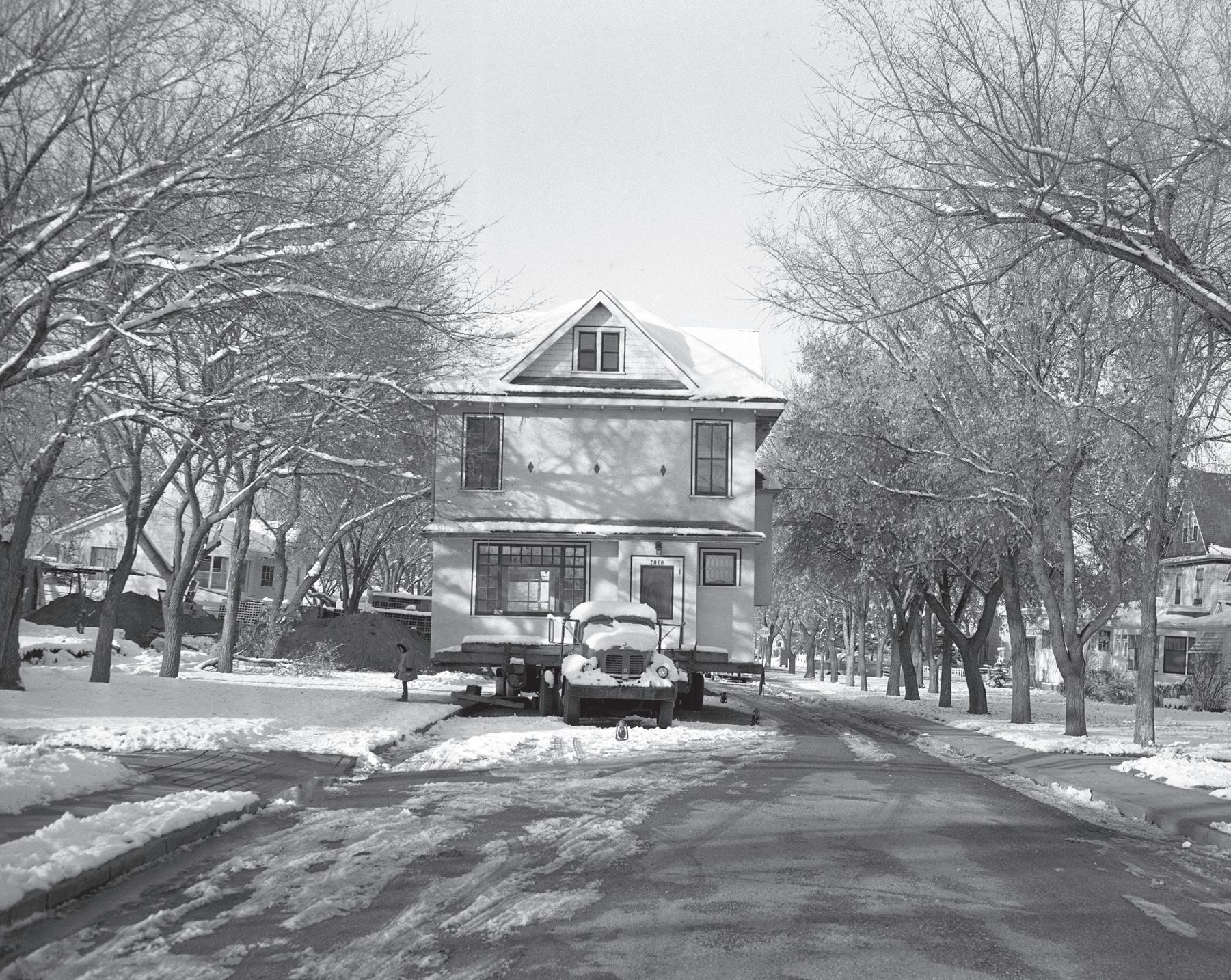
Nowadays, when a developer or a buyer wants something different in a particular spot, they nearly always opt for demolition rather than removal. The
cost of moving an older house and a lack of demand for moved homes can play a role in this, as well as issues with bringing older homes up to building code. But generally, demolition is the rule regardless of what shape the house is in. One heritage advocate we know refers to good quality, older houses in desirable neighbourhoods as, “bulldozer bait.”
She’s not wrong. In the 1920s, they were moving an average of a hundred houses a year in Saskatoon. In 1946 there were a total of 193, counting both those moved within Saskatoon and those coming in from outside. Demolitions in the 1940s and ‘50s averaged one to two a year. As of October of this year, there were more than 200 demolitions and only 11 removals: eight single detached houses, two garages and one commercial building, in a city considerably larger







than in 1946.
Size, location and condition all play a role in whether or not a house can be moved. Houses today tend to be much larger than they were a generation and more ago, making moving them more complex and more expensive. Even something so innocuous as the spacing of the city trees on the property can be a problem. If you can’t fit the house between the trees and onto the street, you can’t move the house.
This may help to explain why so few removal permits are issued today. But one local developer we spoke to suggested that builders also don’t really think about it as an option. Daunted, perhaps, by the complexity of the job, they turn automatically to demolition to clear a site for building.
This developer has some
experience with those complexities. Readers may remember Billy Silverwood’s huge, brick house on Queen Street across from City Hospital. A heritage property, built in 1912, it had served for many years as a women’s shelter (originally the Bethany Home for Unwed Mothers). When the property was sold in 2011, the new owner wanted the land, not the building. The developer, who was planning to move a house off a property he owned on Saskatchewan Crescent, offered to take it away.
How do you move a 500,000 pound building? With “two semi-trailers and a lot of wheels,” he says. And a bit of cash: the final price tag was going to be $150,000.

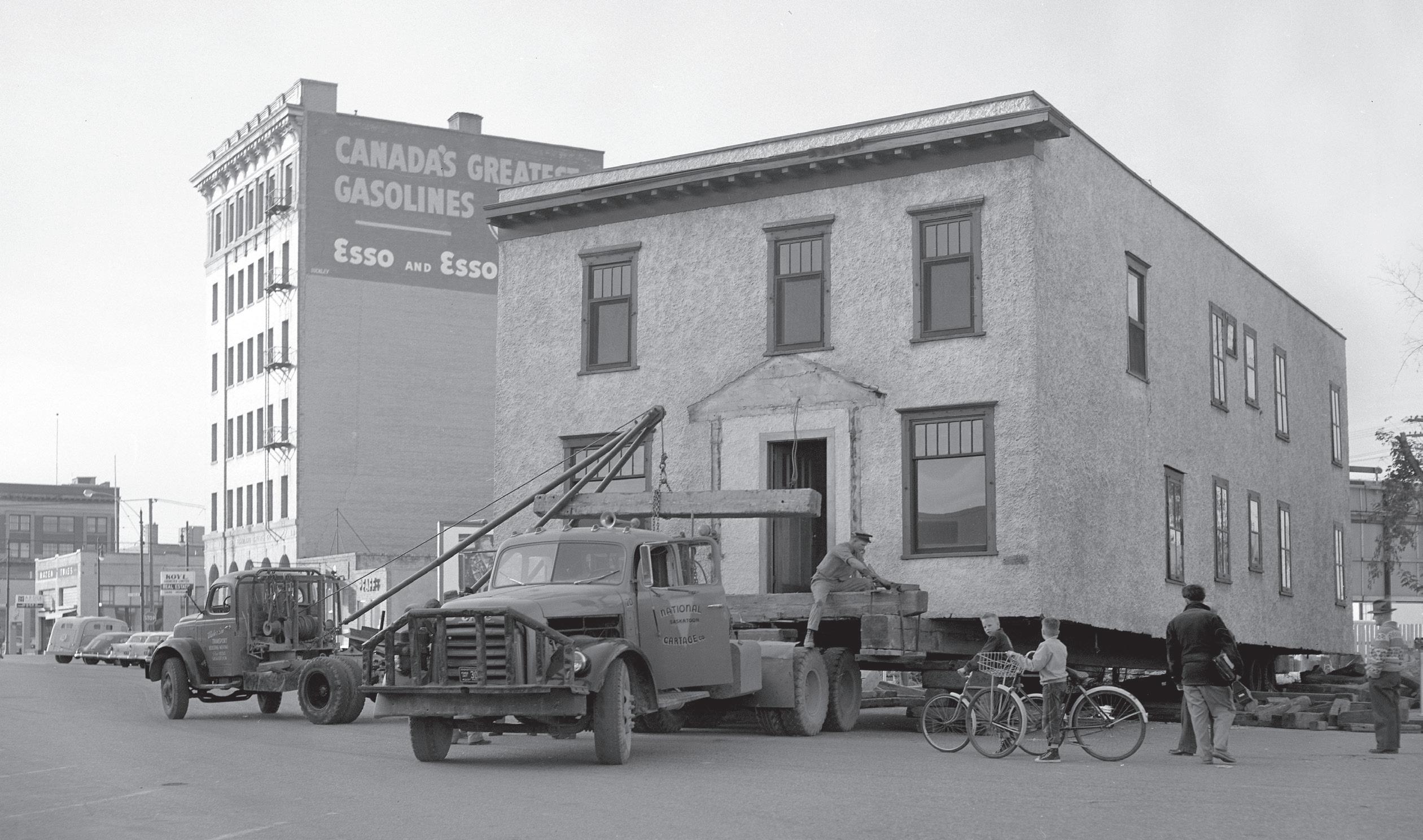
But the massive building was too heavy for the

University Bridge, which would have been the direct route. Instead, they mapped out a route that would take it across the Circle Drive Bridge and up College Drive. But there were problems with that, too. In the end, the project had to be scrapped, and another
piece of Saskatoon’s history ended up in the landfill.
Another thing we learned talking to this developer. When Saskatoon buildings are moved nowadays, they’re nearly always taken out of the city. “There’s not much second life for houses in Saskatoon,” he says.

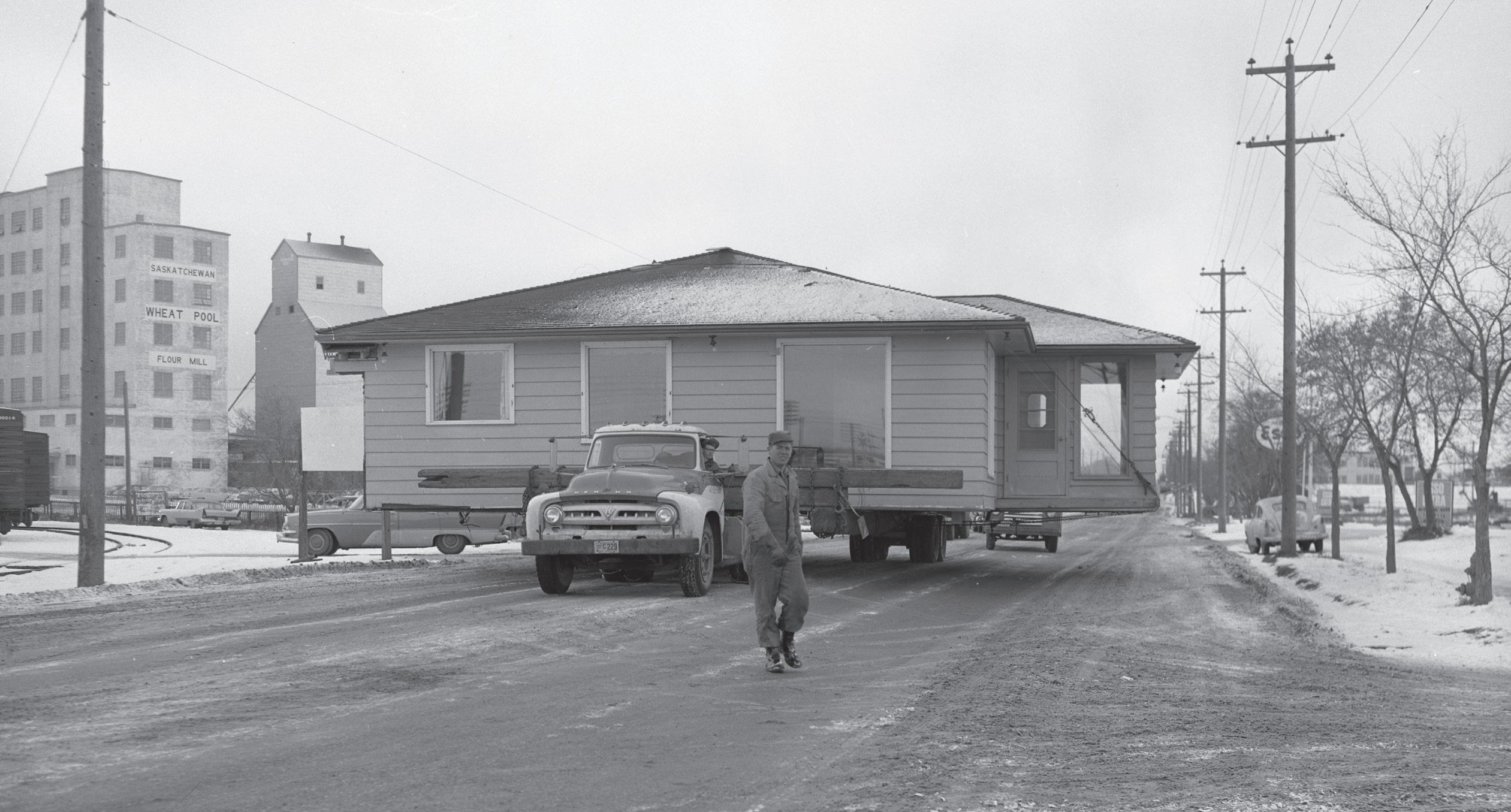
Instead, they almost always end up in one of the local bedroom communities, or as lakefront cabins.
On average, each residential demolition sends 50 metric tons of waste to the landfill. That’s
as much as the average Canadian generates in a hundred years. This makes demolishing a house an expensive proposition, not simply for the cost to knock it down and haul it away, but the long-term cost of maintaining and expanding the landfill. The only cost associated with moving it, on the other hand, is the actual move. Given the alternative of paying to demolish a house or having someone take it away, most builders are going to give it to you for free.
In an era of rising house prices and increasing environmental degradation, it is this writer's opinion that perhaps it’s time for developers and homeowners alike to once again consider the benefits of finding new spaces for older buildings, instead of simply paying to demolish and rebuild.













Winter is a romantic time from early December through the end of February. Here in the prairies, we have a pristine, snow-filled landscape making a beautiful backdrop for celebrations like Hanukkah, Christmas, Kwanzaa, Omisoka, New Year’s and Valentine’s Day, among others. The accompanying music, décor
and attire contribute to the festive mood. Although a calendar celebration isn’t needed to create a romantic dinner for two, the winter season puts many of us in the mood. I try to have the ingredients for some of our favourite meals on hand in case the opportunity to enjoy a spontaneous, intimate celebration presents itself.
When my husband and I were newly married, I started preparing occasional lobster tail dinners. Our children and our businesses were young, and there was little time for conversation, much less romance. In those early days, my husband would come home to have dinner with our family and then go back to work. Sometimes, I would

suggest that he return home for a quiet dinner after the kids were in bed. This worked well while they were small. I have found that traditions need to be reinvented every five years or so.
For us, the menu didn’t matter as much as the intention; candles, table setting and nice outfits were as important for
date night as the meal. Once my husband was home, the lobster and rice went into the oven at 350°F because both require 30 minutes to bake. We would talk and enjoy our cocktails for fifteen minutes at which time I would put the asparagus and mushrooms into the oven. This gave us another fifteen minutes to visit until our feast was ready.

There are many other oven meals one could create for this type of easy entertaining. Years ago, the Saskatchewan Power Corporation employed knowledgeable home economists who worked under the fictional name Penny Powers. One 1960s Penny Powers cookbook is titled Oven Meals , and contains entire menus for cooking the main course, side dishes and dessert in the oven
Select 4 baking dishes that will fit in your oven at once. This entire meal cooks at 350°F so preheat just before the rice and lobster are ready to bake. Make the clarified butter ahead.
Plan to serve a favourite dessert item or a good port with Stilton cheese.
Place 1 cup of butter in a 2-cup glass measure or pitcher.
Cover and microwave on high power until the butter is melted.
Let the butter stand uncovered until the milk solids settle at the bottom.
Gently pour the clarified liquid into a separate dish leaving the milk solids behind.
The clarified butter is the clear butter that you can see through. It has a higher smoke point and can therefore be served in the little pitchers over a candle. Dipping the lobster into this clear butter is very date-night worthy. It feels restaurant-style. Keep any extra clarified butter in the fridge for up to 3 weeks or freeze.
Thaw frozen lobster tails on the counter for about an hour. They will still be slightly frozen. Cut the shell on the back of the lobster tail with meat scissors (or any scissors that are very sharp as the shell can be tough). Spread the shell apart, separating the flesh from the shell using your fingers, a blunt spoon or a butter knife.
Warm a mixture of lemon juice and clarified butter. Add a pinch of garlic powder, if desired.
Place the lobster tails in a baking pan, drizzle with lemon butter and bake for 30 minutes at 350°F. Make sure the flesh is opaque and the shell is pink before serving.
Serve with heated butter-lemon mixture in a tiny pitcher.
Add 2 cups of hot water or broth to a casserole dish. I heat the liquid in the microwave for 3 minutes.
Add 1 cup of white rice to your liquid of choice. Add a teaspoon of butter and a pinch of salt. Cover and bake for 30 minutes at 350°F.
Place enough sliced mushrooms for 2 people in a bowl and add a tablespoon of olive oil. Mix lightly. Spread the mushrooms in a single layer onto a small baking sheet. Sprinkle with coarse salt. Mushrooms require a bake time of 15 minutes at 350°F.
Wash enough asparagus for two servings and snap off dry stem bases. Place asparagus on a baking tray and massage with 2 teaspoons of olive oil. Sprinkle with coarse salt. Asparagus also requires a bake time of 15 minutes at 350°F.
at once. This type of cooking saves energy and time. You can still find Oven Meals in libraries, used bookstores, museums and antique stores. Reading through this book

is inspiring. You’ll be sure to find recipes to stoke those romantic flames.
Maureen Haddock
My first microwave oven had about 750 watts of power. I have adapted this recipe for my 1200-watt microwave oven. We add a lobster tail to leftover pasta, or rice and vegetables, to make a delicious meal in 15 minutes. When we see frozen lobster tails on sale, we stock up and indulge in this change of taste.
10-ounce package of 2 frozen lobster tails

3 tablespoons of butter 2 teaspoons of lemon juice, or more
Remove the wrapping or the bag from the lobster tails. Place them in a microwave-safe pie plate or cake pan.
On power 7 (medium high) cover with wax paper or a microwave cover and microwave the frozen lobster tails for 2 minutes. Remove from the microwave oven and let stand for 5 to 10 minutes or until thawed.

Use kitchen shears to cut lengthwise down the underside of the lobster, right through the shell. Press the tails open flat, which takes some strength. Place them back on the pie plate, meat side up.
In a small dish, melt butter in the microwave oven. This takes 15 seconds on power high. There is no need to clarify butter for this quick and easy treat. Just stir the lemon juice into the melted butter and brush it generously over the tails. Cover and microwave on power 7 for a full minute. Check for flakiness. The tails may need another minute at power 7. Let the lobster rest while you heat your leftovers. Enjoy this mid-week taste sensation!





 BY: KARIN MELBERG SCHWIER
BY: KARIN MELBERG SCHWIER
Ask just about any painter. It all begins with the “anything is possible” white canvas. Untold potential awaits; colours, textures, layers, composition, perspective. Those who understand their role as artist can also create masterpieces of a similar

nature on the snow-covered winter landscape. The trick is understanding what the end result will be well before it’s time to appreciate it.

Helen Shook, a selfprofessed “plant nerd,” is known to many as the voice of Gardenline, a community
outreach program with the University of Saskatchewan (U of S). She works at the College of Agriculture and Bioresources in the Department of Plant Sciences.
During the growing season from May to September, she fields a plethora of
questions from the public about home gardening. She has a Prairie Horticulture Certificate from U of S and is a Master Gardener, and recently developed new courses for that program, manages social media and writes for the website.
She specializes in the prairies and far north, which have a unique climate and soils different from other parts of Canada. She knows whereof she speaks.
It’s easy to forget about lawns and gardens once the snow begins to fall in October or November. Things are tidy, the tools are put away, the earth sleeps; the white quilt is pulled up to its chin. Often it’s not thought of until early spring when attention turns to the seed catalogue. But there are many elements to consider for the white months of the year that make landscapes interesting and beautiful.
“Planning for winter interest is not always considered in planning a garden,” says Helen. “And there are benefits beyond winter beauty such as benefits to birds and overwintering insects such as solitary bees.”


Trees and shrubs provide visual structure and are the
starting point for winter gardens. Ideally, Helen advises, gardeners should use a mix of both deciduous and evergreen plants.
“Consider what trees and shrubs look like from outside,” she says. “Stand in front of your garden or yard and think about what you’d like to see. Do the same from the inside the house, too, and consider the view from the living room or kitchen or any other significant window. It’s a way of bringing the outdoors indoors and connecting us to our gardens year-round.”

In her own home garden, she planted a cedar years ago to provide a green focal point to look at in winter from inside her living room.
“One of the first things I planted when I moved into my house 15 years ago was a Scots pine. I love it for its longish needles, open, airy texture and somewhat asymmetrical form,” she explains. “As it ages, the orangey bark along the branches adds a nice touch of colour and I like the handsome little brown








The place is 400 acres of spectacular prairie paradise located only 5 km south of Saskatoon on Lorne Avenue. Here you can breathe fresh air, bask in warm prairie sunshine, listen undisturbed to prairie songbirds and see the stars at night.

The way of life at Crossmount nurtures the health and wellbeing of all residents with an emphasis on fresh air, independence and tranquility. Crossmount is a community for those 55 and older where old fashioned values and village spirit are prevalent. Crossmount is on city water and is a pet friendly community. Wellness of the individual is embraced and supported with health services available if needed. With many unique amenities and services Crossmount is a one-ofa-kind community.
For more information on independent houses or to schedule a personal tour please email hheimann@crossmountvillage.ca or phone 306-374-9890. www.crossmount.ca
cones. It drops needles and cones in fall onto the mulch beneath the tree which adds another layer of texture.”
Another of Helen’s favourites is dogwood. The bark adds a pop of bright colour that stands out in stark contrast to snow and the dull hues of other dormant or dead foliage. She selected red osier and a yellow stemmed cultivar in her home gardens.
“It’s the biggest challenge. Prairie gardeners are typically concerned with gardening in a cold, dry climate with unique soils,” Helen says. “But a warming climate brings with it more erratic weather patterns including drought, and precipitation that tends to fall as rain in winter and spring which can mean less snow cover. We are trying to teach gardeners methods that can help adapt to these changing conditions."
The most important of these is the use of mulch to protect soil, moderate soil temperature and conserve moisture. But it also changes the way gardeners plan and select plants, shrubs and trees for all four seasons.
Saskatoon was once

considered Zone 2b, but the Canada Plant Hardiness
Zone maps were updated in 2010 using more recent data. Saskatoon is now zone 3b. With a warming climate, Helen expects a zone rating may change again in the next revision of the map.
“Although this means that we can grow a wider variety of woody perennials such as trees and shrubs, and herbaceous perennials like flowers, there are other challenges that come with that.” While temperatures are warmer, erratic weather can affect bloom times and create unpredictable growing conditions in spring and fall.



“I grow a variety of perennial and annual ornamental flowers and leave them standing as they are in fall,” Helen says. “Many have interesting seed heads or pods and stems that peek over the snow line. I don’t cut them down or tidy the garden much in fall.”
Native or species plants bear seeds, while many cultivated plants do not. It’s good to include some native or species plants in the garden just for birds, she suggests.

The stems trap snow, which helps with spring moisture. Both mulch and stems are winter habitat for solitary bees and other beneficial insects. Some plants offer seeds that birds feed on over winter. Helen’s mountain ash and high bush cranberry offer favourite snacks.

“Think of your yard and garden as an ecosystem— because it is one,” Helen advises. “I like having a few plants in each zone of my garden that bear seeds or fruit to feed birds. No pesticides ever. Some densely branched shrubs or hedges may not look like much in winter, but they offer birds protection from predators. A good place to place your bird feeder for days of entertainment and they definitely add interest to a winter garden.”
Karin Melberg SchwierTREES:
Urban properties call for smaller trees. While large shade trees are great in the right spot, mediumsized trees tend to fit the scale of urban properties better. Showy mountain ash—winter berries, interesting bark Thunderchild crab roughly textured interesting bark and tiny apples Amur cherry a stunner with bronze bark Picea pungens ‘Fat Albert’, a smaller cultivar of Colorado blue spruce Upright junipers such as ‘Moonglow’ or ‘Wichita Blue’
SHRUBS:
Ninebark—interesting bark on the stems Dogwoods—both red and yellow stemmed Dwarf balsam fir and Bird’s nest spruce offer evergreen foliage and look interesting with snow on the branches
PERENNIALS:
Grasses—Karl Foerster, Overdam Japanese iris, daylilies and German iris interesting seed heads

Helianthus—sturdy tall stalks retain browned seed heads and petals.
Globe thistle (Echinops)—bluish spiky seed heads Hydrangea—flower heads
To submit a gardening request during the growing season, go to: https://gardening.usask.ca/ gardening-advice/help.php














